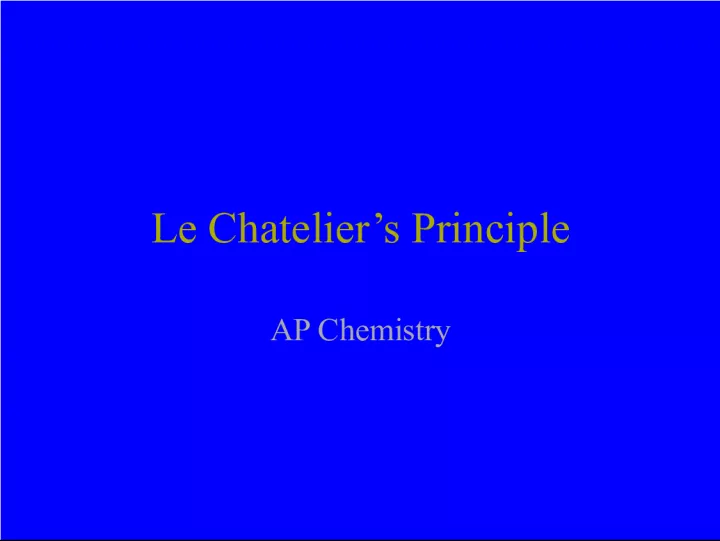Le Chatelier's Principle in AP Chemistry


In AP Chemistry, Le Chatelier's Principle is an essential concept that explains how a system at equilibrium reacts to external stress. This principle states that if a stress is applied to a system
- Uploaded on | 4 Views
-
 alizeeschmitt
alizeeschmitt
About Le Chatelier's Principle in AP Chemistry
PowerPoint presentation about 'Le Chatelier's Principle in AP Chemistry'. This presentation describes the topic on In AP Chemistry, Le Chatelier's Principle is an essential concept that explains how a system at equilibrium reacts to external stress. This principle states that if a stress is applied to a system. The key topics included in this slideshow are . Download this presentation absolutely free.
Presentation Transcript
Slide1Le Chatelier’s PrincipleAP Chemistry
Slide2Le Chatelier’s PrincipleIf a stress is applied to a system at equilibrium, the system will change to relieve that stress and re – establish equilibrium It is like the “undo” button on your computer!
Slide3Factors that Affect Equilibrium• Concentration • Temperature • Pressure – For gaseous systems only! • The presence of a catalyst
Slide4Concentration Changes• Add more reactant Shift to products • Remove reactants Shift to reactants • Add more product Shift to reactants • Remove products Shift to products
Slide5Reaction Quotient• The reaction quotient for an equilibrium system is the same as the equilibrium expression, but the concentrations are NOT at equilibrium! N 2 O 4 (g) 2NO 2 (g) Q = [NO 2 ] 2 [N 2 O 4 ]
Slide6Changes in ConcentrationChanges in concentration are best understood in terms of what would happen to “Q” if the concentrations were changed. N 2 O 4 (g) 2NO 2 (g) Q = [NO 2 ] 2 [N 2 O 4 ] • Q = Keq at equilibrium • If Q< K then there are too many reactants, the reaction will shift in the forward direction (the products) • If Q>K then there are too many products, the reaction will shift to the reactants .
Slide7Temperature ChangesExothermic Reactions • Consider heat as a product in exothermic reactions. – Add heat Shift to reactants – Remove heat Shift to products A + B = AB + Heat
Slide8Temperature ChangesEndothermic Reactions • Consider heat as a reactant in endothermic reactions. – Add heat Shift to products – Remove heat Shift to reactants A + B + heat = AB
Slide9Pressure Changes• Only affects equilibrium systems with unequal moles of gaseous reactants and products.
Slide10N2 (g) + 3H 2 (g) = 2NH 3 (g) • Increase Pressure – Stress of pressure is reduced by reducing the number of gas molecules in the container . . . . . .
Slide11N2 (g) + 3H 2 (g) = 2NH 3 (g) • There are 4 molecules of reactants vs. 2 molecules of products. – Thus, the reaction shifts to the product ammonia.
Slide12PCl5 (g) = PCl 3 (g) + Cl 2 (g) • Decrease Pressure – Stress of decreased pressure is reduced by increasing the number of gas molecules in the container .
Slide13PCl5 (g) = PCl 3 (g) + Cl 2 (g) • There are two product gas molecules vs. one reactant gas molecule. • Thus, the reaction shifts to the products.
Slide14Presence of a Catalyst• A Catalyst lowers the activation energy and increases the reaction rate. • It will lower the forward and reverse reaction rates, • Therefore, a catalyst has NO EFFECT on a system at equilibrium! • It just gets you to equilibrium faster!
Slide15Presence of an Inert Substance• An inert substance is a substance that is not- reactive with any species in the equilibrium system. • These will not affect the equilibrium system. • If the substance does react with a species at equilibrium, then there will be a shift!
Slide16•Given: • S 8 (g) + 12O 2 (g) 8 SO 3 (g) + 808 kcals • What will happen when …… • Oxygen gas is added? • The reaction vessel is cooled? • The size of the container is increased? • Sulfur trioxide is removed? • A catalyst is added to make it faster? Shifts to prodcuts Shifts to Products – to replace heat V increases, Pressure decreases, shifts to more particles – to reactants! Shift to products to replace it! No change!
Slide17Given 2NaHCO 3 (s) Na 2 CO 3 (s) + H 2 O (g) + CO 2 (g) • What will happen when . . . . . . . • Carbon dioxide was removed? • Sodium carbonate was added? • Sodium bicarbonate was removed? Shift to products – to replace it No Change – solids to not affect equilibrium No Change
Slide18•Given Ca 5 (PO 4 ) 3 OH(s) 5Ca 2+ (aq) + 3PO 4 3- (aq) + OH- (aq) • What will happen when. . . . . . • Calcium ions are added? • NaOH is added? • 1 M HCl is added? • Na 3 PO 4 (aq) is added? Shift to the reactants Adding OH- , shifts to reactants H+ + OH- H2O (removes OH-, shifts to products) Adds PO 4 3- ions, shifts to reactants